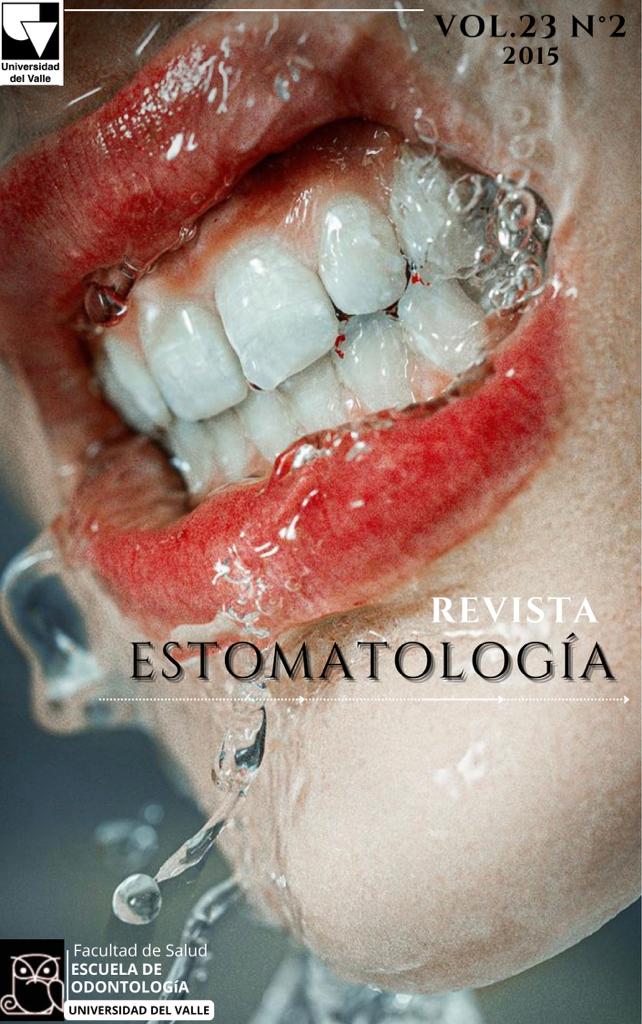Clinical description of the tissue response on intraoral tattoos (new forms of body art): Pilot study
Main Article Content
Objective: Describe the clinical changes observed in the oral mucosa after intraoral
tattoos, evaluate tissue reactions for modifications of this type.
Materials and methods: It made aa descriptive study of the clinical changes in the oral mucous was made in 11 patients who had had intraoral tattoos were interviewed to obtain general information such as age, socioeconomic status, educational level, presence of extraoral tattoos, body modifications, relevant medical history or problems with their modifications, intraoral tattoos collected data for the design, made
date, color type, location, changes and clinical findings among others. There was a complete stomatological examination, photographs were taken of body modification, intra and extra oral tattoos, it made Photograpic control and monitoring was made at 8, 15, 30 and 60 days before, an data collected in simplified tables.
Results: All patients had at least one previous body modification. The most common site of intraoral tattoo was on the lower lip, the design was used with letters, tattoos are preferred monochrome, usually black pigment after 15 days the oral mucous does not seem to irreversible damage at 60 days the tattoo is stabilized, lost some color and definition but apparently does not produce any clinically relevant change.
Conclusion: Within the limits of this investigation shows that the material used (pigment black) appears to be biocompatible. Not exist treaty or regulation on the use of specific inks, techniques, types of needle or calibration in the tattoo machines when are making a tattoo in this area, tattoo artists refer to work as best they feel and inks that are reliable on their clinical experiences . Biosafety at the sites of body modifications are becoming more strict and regulated.
Key words:Tattoo, intraoral, lip.
2. Armstrong ML; Masten Y; Martin R. Adolescent Pregnancy, tattooing, and risk taking.MCN Am J Matern Child Nurs 2000;258-61.
3. Haley RW, Fischer RP. The tattooing paradox: are studies of acute hepatitis adequate to identify routes of transmission of subclinical hepatitis c infection? Arch Intern Med. 2003; 163:1095-8.
4. Rodrigo Ganter S. De cuerpos, tatuajes y culturas juveniles.Espacio Abierto 2006;15:427-53
5. Diccionario Real Academia Lengua Española on-line http://buscon.rae.es/draeI/
6. Kazandjieva J, Tsankov N. Tattoos: dermatological complications. Clin Dermatol 2007; 25:375-82.
7. Irezumi GW. The patern in dermatography in japan.Leiden. Brill;1982.
8. Laumann AE, Derick AJ. Tattoos and body piercings in the United States: A national data set. J Am Acad Dermatol 2006; 55:41321.
9. Mercier FJ, Bonnet MP. Tattooing and various piercing : an aesthetic considerations. Curr Opin Anaesthesiol 2009; 22:436-41.
10. Carroll ST, Riffenburg RH, Roberts TA, Myhre EB. Tattoos and body piercings as indicators of adolescent risk-taking behaviors. Pediatrics 2002; 109:1021-7.
11. Chimenos-Küstner E, Batlle-Travé I, Velásquez-Rengifo S, García-Carabaño T, Viñals-Iglesias H, Roselló-Llabrés X. Estética y Cultura: Patología bucal asociada a ciertas modas “actuales” (tatuajes, perforaciones bucales, etc.). Med Oral 2003; 8:197-206.
12. Kluger N, Koljonen V. Tattoos, inks and cancer. Lancet Oncol 2012; 13:161-8.
13. Kluger N. Cutaneous complications related to permanent decorative tatooing. Expert Rev Clin Immunol 2010; 6:363-71.
14. Armstrong ML, McConnell C. Tattooing in adolescents, more common than you think: the phenomenon and risks. J Sch Nurs 1994; 10:22-9.
15. Liszewski W, Kream E, Helland S, Cavigli A, Lavin BC, Murina A. The Demographics and Rates of Tattoo Complications, Regret, and Unsafe Tattooing Practices: A Cross-Sectional Study.Dermatol Surg.
2015;41:1283-9.
16. Swami V. Marked for life? A prospective study of tattoos on appearance anxiety and dissatisfaction, perceptions of uniqueness, and self-esteem. Body Image 2011; 8:237-44
17. Roberts TA, Ryan SA. Tattooing and high-risk behavior in adolescents. Pediatr 2002; 110:1058-63.
18. Zegarelli E, Kutscher A, Hyman G. Diagnostico en Patología Oral. Ed Salvat ; 1980.
19. Mahalingam M, Kim E, Bhawan J. Morphea-like tattoo reaction. Am J Dermatopathol. octubre de 2002 ; 24(5):392-5.
20. Playe, Stephen J. Infectious Complications of Body Art: Infection is reported in about 1% of tattoos and in up to 45% of piercings, depending on the technique employed, body location, and after care. Emerg Med News. julio de 2002; 24(7):10-3.
21. Telang GH, Ditre CM. Blue gingiva, an unusual oral pigmentation resulting from gingival tattoo. J Am Acad Dermatol. enero de 1994; 30(1):125-6.
22. Al-Shawaf M, Ruprecht A, Gerard P, et al. Gingival tattoo, an unusual gingival pigmentation. J Oral Med 1986; 41:130-3.
23. Kilmer SL, Garden JM.Laser treatment of pigmented lesions and tattoos.Semin Cutan Med Surg. 2000; 19:232-44.
24. Gazi M. Unusual pigmentation of the gingiva. Oral Surg Oral Med Oral Pathol 1986; 62:646-9.
Downloads
Los autores/as conservan los derechos de autor y ceden a la revista el derecho de la primera publicación, con el trabajo registrado con la licencia de atribución de Creative Commons, que permite a terceros utilizar lo publicado siempre que mencionen la autoría del trabajo y a la primera publicación en esta revista.

